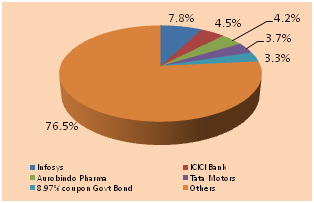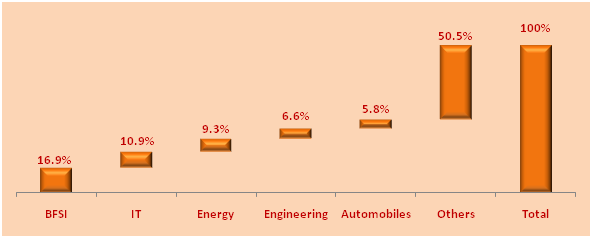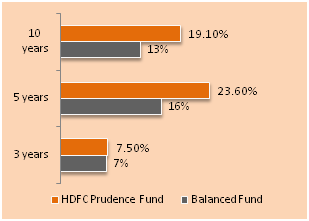Mutual Fund Review: HDFC Prudence Fund

Balanced funds are excellent investment options for investors with moderate risk tolerance, since they give very good risk adjusted returns. It is very surprising why balanced funds are not nearly as popular as diversified equity funds, despite being around in India for nearly two decades. Balanced funds are essentially hybrid funds with both debt and equity in its portfolio mix, to balance the portfolio risk. These portfolios typically hold up to 70% of its portfolio assets in equities and the balance in fixed income. On a risk adjusted basis, balanced funds have delivered excellent returns compared to other equity fund categories, e.g. large cap or diversified equity mutual funds. The chart below shows a comparison of category returns between large cap funds and balanced funds over the time periods shown below (based on Apr 1, NAVs)

The above chart clearly shows that, while in terms of absolute returns the performance differential between diversified equity funds and balanced funds is not very significant, at the same time balanced funds have much lower risks compared to their diversified equity counterparts.
Within the balanced funds category, the HDFC Prudence fund has been the best performing fund in terms of last 10 years annualized returns. It has not only consistently outperformed the balanced fund category, but also outperformed many equity oriented funds during this period. See the chart below, for the comparison of annualized returns over one, three, five and ten year periods, between HDFC Prudence Fund (Growth Plan) and the balanced fund category (NAVs as on Apr 1)
-and-Balanced-Funds-Category.png)
HDFC Prudence Fund – Fund Overview
This fund is suitable for investors looking for long term capital appreciation with moderate levels of risk. As such the fund is suitable for investors in the moderate risk category planning for retirement or other long term financial objectives. The HDFC Prudence Fund was launched in December 1993. As one of the oldest schemes in its category, the fund has reached a huge AUM base of Rs 5,080 crores with an expense ratio of 2.02%. HDFC AMC is the largest asset management company in India, is widely recognized as amongst the best performers across most mutual fund categories. The fund is managed by industry veteran, Prashant Jain (since 2003) and Rakesh Vyas (since 2012). Prashant is known as one of the best fund managers in the industry with keen eye for buying high quality stocks at attractive valuations and holding them for long term capital appreciation. Prashant has a long term outlook and sticks to his conviction, even at the cost of short term under performance. The scheme is open both for growth and dividend options. The current NAV (as on Apr 1 2014) is 265.7 for growth option and 25.1 for dividend option.
Portfolio Construction
In terms of portfolio construction, equity comprises 75% of the portfolio mix while fixed income securities comprise the rest. The portfolio has a large cap bias with a value orientation. It is very well diversified with its top 5 holdings, Infosys, ICICI Bank, Aurbindo Pharma, Tata Motors and 8.97% coupon Government of India Bonds of 2030 maturities, accounting for less 24% of the total portfolio value. The quality of its debt portfolio is also quite high with limited interest rate sensitivity.


In terms of sector composition of the equity portfolio, BFSI, IT, Energy, Engineering and Automobile have the highest portfolio weights, combining to little less than 50% of the portfolio value. While the portfolio is slightly biased to cyclical sectors, it also has substantial allocations to defensive sectors with IT, Pharma and FMCG comprising 20% of the equity portfolio. Within the fixed income portfolio government bonds account for over 69% of the fixed income portfolio, corporate bonds account for 27% and other fixed income instruments account for the balance. See the waterfall chart below, for the sector composition of the equity portfolio of HDFC Prudence Fund.

Risk & Return
From a risk perspective, the volatility of the fund is on the higher side, given the fact that it is a balanced fund. The annualized standard deviations of monthly returns of HDFC Prudence Fund for three to fifteen year periods are in the range of 16% and 20% respectively, which is on the higher side relative to the balanced funds category. While the high volatility is a watch out for the fund from a risk perspective, the higher returns delivered by the fund over the different time periods are commensurate with the risk. See charts below for comparison of volatilities and returns between HDFC Prudence fund and.


Comparison with Peer Set
A comparison of annualized returns of HDFC Prudence Fund versus its peer set over various time periods shows why this fund is considered the best performer in the long term. The fund has slightly underperformed versus its top peers in the last three years, but it has outperformed all its peers in terms of trailing annualized returns in the last 5 and 10 years. See chart below for comparison of annualized returns of HDFC Prudence fund and its top performing peers over one, three, five and ten year periods. NAVs as on Apr 1 2014.

Dividend Payout Track Record
HDFC Prudence Fund (Dividend Plan) has an excellent dividend payout track record. For the last 15 years the fund has paid dividends every year. The fund did not miss paying dividends even during the market downturns in 2008 and 2011. The table below shows the dividend payout track record of the HDFC Prudence Fund (Dividend Plan)
.png)
SIP and Lump Sum Returns since Inception
The chart below shows returns as on April 1 2014 (NAV of 265.7) of Rs 5000 monthly SIP in the HDFC Prudence Fund Growth Plan, for respective years starting since inception. The SIP date has been assumed to first working day of the month. The amounts are shown in Rs lakhs.

The chart above shows that a monthly SIP of Rs 5000 started on inception of the fund would have grown to over Rs 1.35 crores, while the investor would have invested only Rs 12 lakhs. This shows the power of compounded return. If the investor started his SIP 10 years back, his investment would have grown nearly 2.5 times. The internal rate of return of the SIP investment from inception is almost 19%, which is exceptionally good, given the fact that the HDFC Prudence Fund is a balanced fund with limited downside risks. If the investor had invested Rs 1 Lakh lump sum in the NFO, his wealth would have grown to nearly Rs 27 lakhs.
Conclusion
HDFC Prudence Fund has recently completed 20 years. The fund has an established track record of strong long term performance. It is a top pick in many investor portfolios. Investors with moderate risk profiles may consider this product for their retirement planning and other long term financial objectives, through systematic investment plans or lump sum route with a long time horizon. Given its good dividend pay-out track record, investors who prefer dividends can opt for the dividend plan of the HDFC Prudence Fund. Investors should consult with their financial advisors, if this scheme is suitable for their financial planning objectives.
Queries
-
What is the benefit of mutual fund STP
Aug 29, 2019
-
How much to invest to meet target amount of Rs 2 Crores
Aug 26, 2019
-
Can I achieve my financial goals with my current mutual fund investments
Aug 24, 2019
-
Can you tell me return of various indices
Aug 19, 2019
-
What would be the post tax return on different investments
Aug 18, 2019
-
Which Principal Mutual Fund scheme will be suitable for my retirement corpus
Aug 16, 2019
-
What is the minimum holding period for availing NCD interest
Aug 4, 2019
Top Performing Mutual Funds
Recommended Reading
Fund News
-
Axis Mutual Fund launches Axis Gold and Silver Passive FOF
Dec 10, 2025 by Advisorkhoj Team
-
Jio BlackRock Mutual Fund launches JioBlackRock Arbitrage Fund
Dec 9, 2025 by Advisorkhoj Team
-
Tata Mutual Fund launches Tata BSE Multicap Consumption 50:30:20 Index Fund
Dec 9, 2025 by Advisorkhoj Team
-
Edelweiss Mutual Fund launches Edelweiss Silver ETF Fund of Fund
Dec 8, 2025 by Advisorkhoj Team
-
Abakkus Mutual Fund launches Abakkus Liquid Fund
Dec 8, 2025 by Advisorkhoj Team














